Riding the Ruta de la Plata, part 2
Follow-up to Riding the Ruta de la Plata, part 1 from Transversality - Robert O'Toole
See by motorcycle to Seville through rural Spain, part 1 for an account of the first day of this trip.
Day 2
It was entirely obvious, surely? The obstacle had first appeared as the boat drifted into Santander harbour; in the distance to the south west, but massive enough as to clearly establish psychogeographical dominance over the landscape; an attractor re-aligning the paths of south-bound travelers. For an expedition like ours, the possibility was irresistible. And yet I did not consciously consider a crossing at altitude through the snow until deep drifts began to appear at the roadside. To a simple English mind Spain equals sunshine, warmth, and near desert conditions. Concentrate that simple mind upon the task of keeping a heavily loaded GS bike upright and on track through some of the most “exciting” roads in the world, and there is no time for reflecting upon the absurdity of these preconceptions concerning the climate. Of course Spain has many mountains, some quite big. By the time we were at the top throwing snow balls, the sense of surprise was still overwhelming.
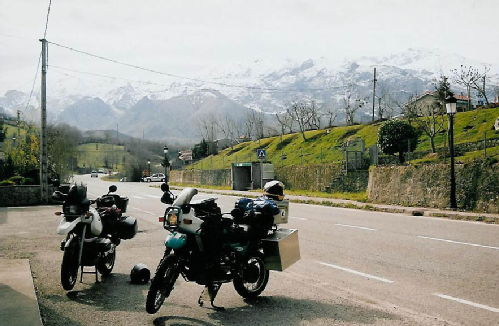
On our first day in Spain we had ridden a short way from Santander and into the Picos de Europa National Park. The following morning, mountain air and the sounds of wilderness accompanied breakfast and strong coffee in a nearby café bar. A pathway led from the campsite upwards to a viewpoint looking out over the valley. From the west, the Rio Cares surges through the valley. To the east it passes through a gorge in the limestone cliffs. On my 1/250,000 scale
When viewed from the side of the valley, the Cares River looks insignificant compared to the surrounding mountains. The camp site extends almost to the banks of the river, but not quite all of the way. Access is barred by a tall metal fence, with only one sturdy gateway. The fence says something about the true power of the waters. Even the Spanish, with their pathological disregard for health and safety, would not want unaccompanied children going anywhere near a river like this. A snapshot at this point would be misleading. Even close up it can look insignificant. Its real power is made obvious by the thundering sound that it produces as it travels at great speed through the narrow passage of its course. I guess that the snow fields at higher altitudes must be melting, adding to the volume and speed of water. Melting snow changes the character of a river; not just its power, but also its beauty. This would be hard to capture on film. Perhaps a professional photographer could match the colour adequately: a vivid turquoise blemished only by the occasional tree branch passing at speed. However, its
At the start of the day, with the sun rising rapidly into the gap between the overlapping walls of limestone along the zigzagging path of the river, light patches of fog are lifted upwards. A golden eagle soon followed them, finding and exploiting the day’s first thermal. We could hear it calling hundred’s of metres above us, far beyond the clanking bells of the goats on top of the ridge behind the camp. We would soon follow its example, and get out chasing the warmth of the day ourselves.
Westwards, the shape of the road already provided interest, through the small town of Poo (
A little beyond the centre of Cangas, we turned southwards into the Picos. Before going too far, I stopped to check the map. A twisty looking road was ahead. And yet I still did not realise just what we were heading for. We did know that this ride would be worth recording, and so Martin decided to try a new technique: with tape he attached a small Mini-DV video camera to the “beak” at the front of his R1100GS, using a small patch of foam to eliminate vibrations. After some more experimentation, a good recording was made, and the results are currently being edited.
Martin Conquers the Mountain
I admit that I am not a particularly fast rider. Also, unlike Martin, I didn’t have the incentive of a video camera strapped to the front of my bike. My ride through the Desfiladero de los Boyes was slow, cautious and concentrated on scenery. Martin, I’m sure, saw just as much of this amazing gorge as I did. But after waiting for me at our first stop half way through the gorge, it was impossible for him to hide his “where have you been for the last ten minutes” expression. Where had I been then? Pottering in amazement along a really great road. The Desfiladero runs along the wall of the cliff that rises almost vertically alongside the Rio Sella, through the Picos mountain range. At times it seems to head directly into the fearsome rapids of the river, only to twist back upon itself at the very last moment.
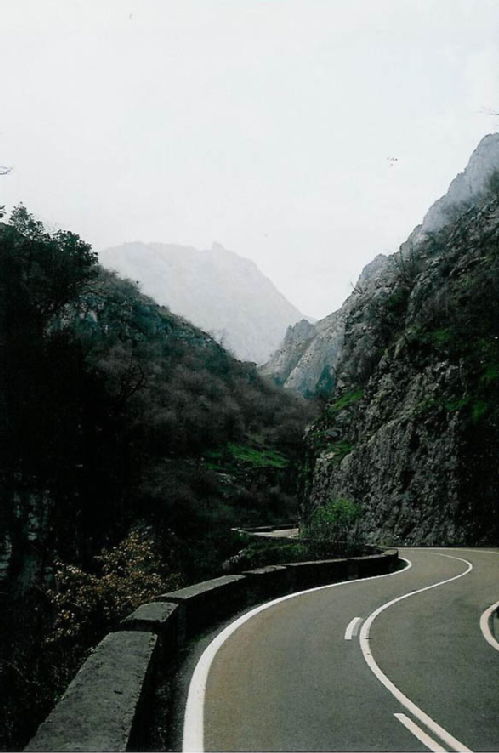
Between the wall of the cliff and its continuation at the edge of the road there seems to be barely enough space for two vehicles.
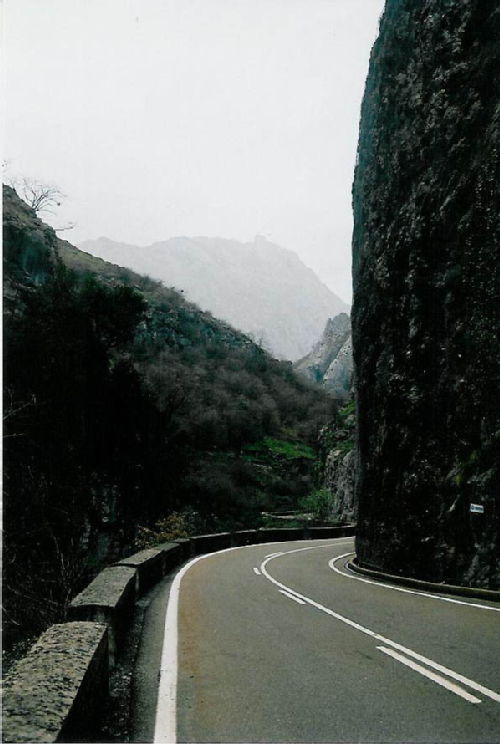
The narrowing sensation is accentuated by rock overhangs. The surface of the road is excellent, apart from where water runs across it at the base of mini waterfalls. Rocks and mud add further hazards, falling in large chunks often just out of sight in blind corners. Fortunately the traffic is light, especially given the local tendency to drive
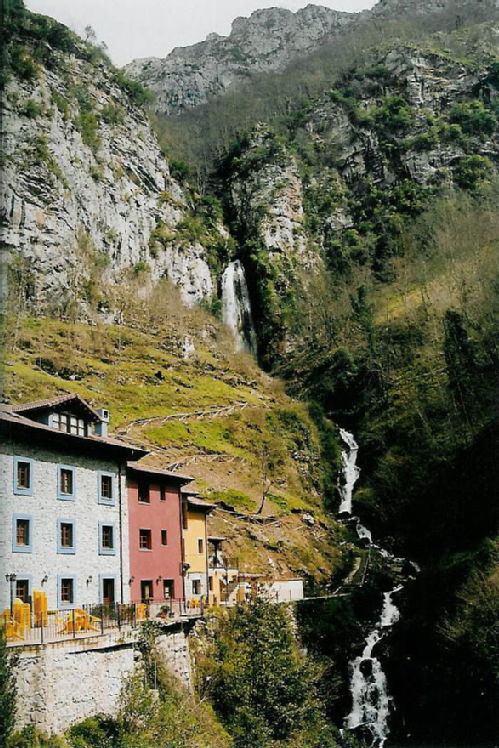
Until this point the road stayed at quite low altitude. I still did not really think about the likelihood of it heading significantly upwards, despite its accent being marked clearly upon the map. Very soon after the waterfall, things changed. I didn’t really notice much of incline to start with. I did notice a change in the temperature. Down in the gorge, when away from the shadows, the sun provided warmth. Further into the mountain road, away from the river, I could feel the temperature dropping (perhaps by 1 degree per 100 metres, as is often stated). Wearing only summer clothes, with the air vents open, I began to feel a little chilly (though not that chilly, as I barely topped 30mph). The surface of the road started to deteriorate a little. Frost shattering does bad things to tarmac. We had already seen signs warning of ice. With water flowing across tight hairpin bends, some with adverse cambers, I regarded the warnings with some nervousness. Glancing away to the sides of the road, I started to see what looked like tiny glaciers up above. Just after the first of these mini glaciers, the snow poles started, at regular distances: striped with red and white to mark out heights, they act to provide a visual indication of the edge of the road when it is buried in deep snow. I considered a possibility: what if there were snow on the road ahead? Would we continue? Could we? I’ve ridden the GS in deep snow before, but on
As the road twisted upwards the snow deepened. I was now surrounded by a landscape that at lower altitude could only belong to mid-winter. As we reached the top of the pass, the views to each side opened out revealing snow fields stretching into the distance. The curves of the road became less extreme as we turned towards the sign marking the Peurto del Ponton pass at 1,280 metres. Just as we approached the top, an eagle swooped by (Bonelli’s eagle I think).
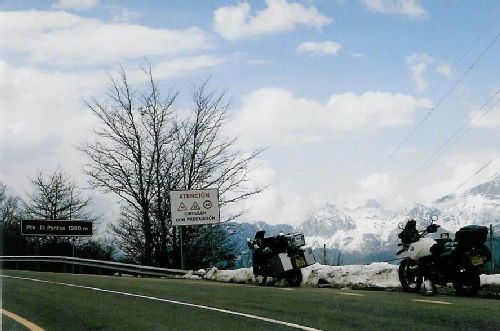
The road down was less technical, but still through snow. After a short distance the large Embalse de Riano reservoir came into view, looking more like a Norwegian fjord.
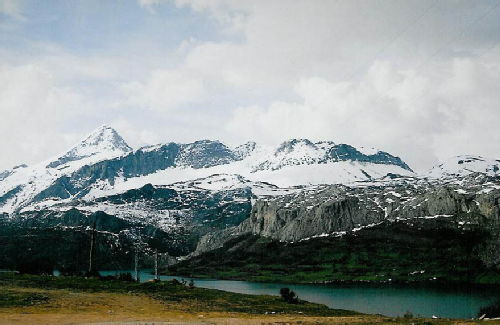
I passed quickly over a small bridge and then a much more impressive dam wall, to find Martin yet again waiting for me just outside of the town of Riano. We stopped to look at the scenery, and the snow.
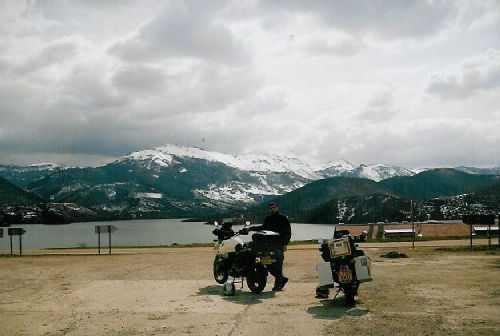
A vulture drifted past. We agreed, this was a really great journey.
Where to next?
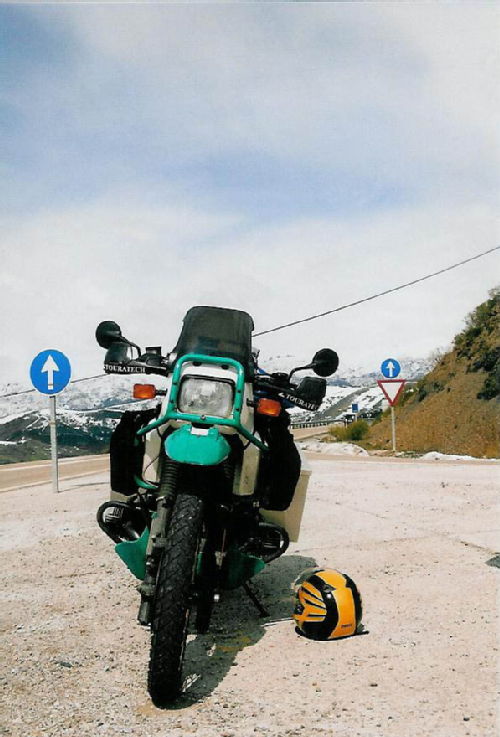
 Robert O'Toole
Robert O'Toole

Add a comment
You are not allowed to comment on this entry as it has restricted commenting permissions.